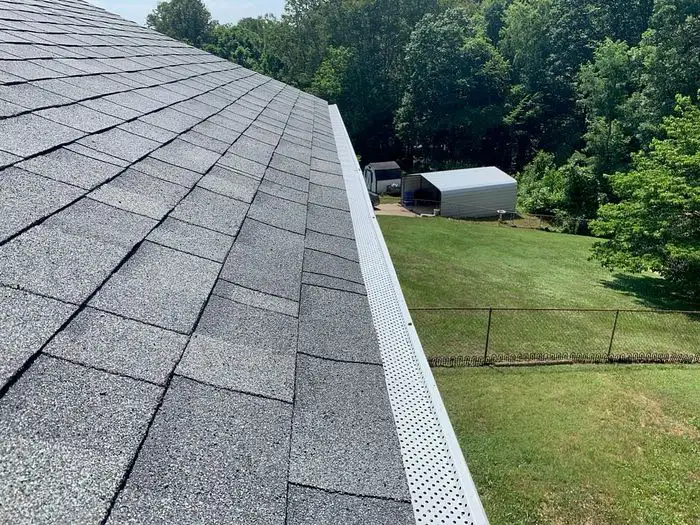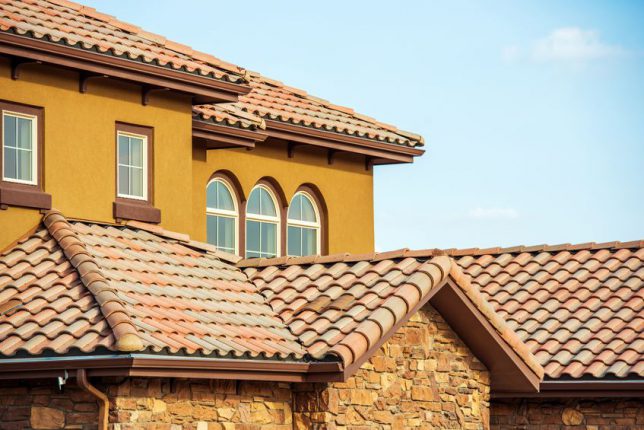
Are you wondering how to determine what roofing material is the best choice for your climate? Choosing the right roofing material can be difficult, with numerous factors impacting your decision. From weather patterns to style, so many variables come into play when selecting a metal roof for your home or business.
Knowing which type of material can efficiently protect from harsh weather conditions will help you make an informed and financially sound decision. In this blog post, we’ll discuss the different types of materials available and what hot and cold climates they work best in. By addressing all aspects of purchasing and protecting your new investment, we hope to empower you to select the perfect option for your unique application needs!
Asphalt Roofing Shingles

Asphalt roofing shingles are one of the most popular and cost-effective materials for homeowners. They come in various colours, textures, and styles to match any home or business aesthetic. Asphalt shingles are up to the task when it comes to protecting from weather elements such as wind, hail, and extreme temperatures. They are also cost-effective, making them a great choice for those on a budget.
Asphalt roofing shingles work best in cooler climates like the northern United States and Canada and areas with moderate temperatures that don’t get too hot or cold. This makes asphalt roofing shingles ideal for regions that experience snowfall, as the shingles are designed to keep moisture from seeping into your home.
Tips to Choose the Right Roofing Material for Your House
Consider Your Climate: Different roofing materials are better suited for different climates. For instance, asphalt shingles may not be suitable in areas that experience heavy snowfall, while metal roofs may be perfect for this region due to their strong and durable design. Look for Durable Materials: When choosing a roofing material, consider its durability and longevity. Metal roofing is a great option since it’s low maintenance and has a long lifespan compared to other materials.
Check the Fire Rating: How well a material can withstand fire is another important factor when selecting your roofing material. Asphalt shingles have a Class A rating and are one of the most fire-resistant materials available.
Consider Your Budget: It’s important to stay within budget when selecting a roofing material. Materials such as asphalt shingles and wood shakes are the most affordable options, while metal and clay tiles are more expensive.
Aesthetics: The last thing you must consider is how the material will look on your property. Do you prefer a sleek and modern look or a more traditional style? Different materials can provide various aesthetic effects, so select one that fits your home’s overall design.
Considering these factors, you can pick the best roofing material for your climate. Investing in the right roof will help protect your home from the elements and will last for years.
Consider the Durability of the Roofing Material for Your Area

When selecting a roofing material for your home or business, you need to consider the product’s durability of your local climate. How well can it stand up to extreme heat and cold? How resilient is it against strong winds and rain? Does it require regular maintenance and repairs, or is it designed to last longer without as much upkeep?
Certain materials that work well in one climate may not be as effective in another. For example, asphalt shingles are an affordable and popular choice for many homeowners. Still, they are less resilient to high-wind areas than other materials like metal or stone-coated steel. Additionally, wood shakes and shingles look great but are not as durable in humid climates, where they may rot over time.
Think about the local climate and weather conditions when selecting a roofing material. How much sun, rain, wind, and snow will it be exposed to? How intense is the heat or cold during different times of the year? By understanding your regional climate patterns, you can better choose a material that suits your climate and provides adequate protection.
With the right roofing material, you can know your home or business is well protected from even the harshest weather conditions. If you need additional guidance in selecting the best roofing material for your area, contact a professional roofer to help you make the right decision.
They can provide expert advice and help you select the best material for your climate that fits your budget. With a reliable roofing system, you can be sure that your home or business is safe from damage caused by weather. Make the right decision today and ensure your property’s protection for years.
Terra-Cotta Tiles and Ceramic Roofs
For climates that experience extremely warm temperatures, terra-cotta tiles and ceramic tile roofs are ideal choices. These highly durable materials will block the sun’s heat to keep your home or business cooler. They also have excellent water resistance properties, making them great for rainy climates. Terra-cotta is a popular choice in urban areas, as it has a unique look and can fit any home style.
Faux Slate Roofing Shingles
Faux slate roofing shingles are a great option for homeowners looking to achieve the look of traditional slate without the hefty price tag. Faux slate is composed of fibre cement slates and has been designed to emulate real slate’s texture, appearance, and durability. This type of material works best in climates that experience moderate weather conditions, such as rain and snow.
It’s a great choice for residential roofs because it offers superior protection against these elements while providing an aesthetically pleasing look. Faux slate is also easy to install and maintain, making it an ideal roofing material for any climate.
Concrete Tiles and Slab Roofs
Concrete tiles and slab roofs are among the most popular roofing materials in areas with extreme heat. They absorb sunlight during the day, which helps keep your building cool and provides excellent protection from rain and other weather conditions like hail.
Concrete tiles and slabs have a long lifespan, require minimal maintenance, and come in various colours and styles. They are also energy efficient, helping to reduce your carbon footprint. However, they can be heavier than other materials, so ensure your home or business has the right foundation before installing this roofing material.
Cool Color Concrete Tile
Concrete tile is a popular roofing choice due to its durability and long-term performance. This material is also incredibly resistant to rain, hail, and other severe weather conditions. The main advantage of this material is its light colour which helps reduce the amount of heat transfer into your home or building.
Because concrete tile has a cool colour, it also helps reduce your energy bills significantly. This type of roofing is ideal for anyone living in a hot and humid climate, as it allows you to stay cool without cranking up the air conditioner. It’s important to note that concrete tiles can be heavy and may require additional support if installed on an older structure.
Warranty and Installation
When selecting a roofing material, it’s also important to consider the warranty and installation process. Different materials often come with different warranties that can affect your decision-making process. Quality roofs for your home or business should have long-term warranties that the manufacturer backs.
Professional installation by a certified roofer is essential to ensure your roof can withstand serious weather conditions. If you opt for a DIY install, knowing what type of material best suits your climate and any potential risks associated with an improper installation are important.
The cost of the installation and materials can also be a factor in determining which roofing material is best for your climate. Different materials may have different costs depending on the job’s type, size, and complexity. Quality materials often come with a higher price tag but may save you money in the long run due to their durability and longevity.
Metal Roofing
Metal roofing is an ideal choice for regions that experience harsh weather conditions, such as heavy snowfall or high winds. It has been proven to be one of the most durable and long-lasting materials available today.
Metal roofs are typically made from aluminium or steel, with copper and zinc being popular materials. The material is incredibly lightweight and can easily be installed over existing roofs. Furthermore, metal roofing or green roofs reflect sun rays which can help keep your home cool in the summer while preventing ice buildup during winter weather.
EPDM Roofing Membranes
EPDM (Ethylene Propylene Diene Monomer) roofing membranes are rubber membranes often used on commercial flat roofs. They can withstand extreme temperatures and weather conditions, including exposure to ultraviolet rays, hail, and high winds. EPDM works best in climates where there are frequent storms or extreme temperatures.
FAQs
What type of roof is best for a hot climate?
Metal roofing is the best choice for hot climates, as it reflects the sun’s rays and helps keep your home cool. It is also highly durable and can withstand extreme weather conditions.
Which roof is best for rainy climates?
Asphalt shingles are the best choice for rainy climates, as they provide superior protection against water damage and wet weather. They come in various styles and colours, so you can find the perfect look to complement your home’s exterior.
What type of roof is best for cold climates?
Which roof colour is best for a hot climate?
Light-coloured roofs are the best choice for hot climates, as they reflect heat and cool your home. Metal roofing is a popular option, as it is highly reflective and durable. Darker colours should be avoided in hot climates, as they absorb heat and can make your home hotter.
What type of roof keeps the house the coolest?
Metal roofing is the best choice for keeping your home cool, as it reflects heat and can help reduce energy costs. Metal roofs also come in various colours and styles, so you can find something that fits your home’s aesthetic.
What is the best roof for high winds and hot climates?
Metal roofing is the best choice for high winds and hot climates, as it can withstand harsh weather conditions. It is also highly reflective and can help keep your home cool in warmer months. Additionally, metal roofs come in various colours and styles to fit any home’s aesthetic.
Conclusion
Choosing the right roofing material for your home can seem daunting, but with the right research and preparation, it doesn’t have to be. Consider your climate; do you live in an area with high temperatures and lots of sun exposure? Or maybe you live somewhere that requires protection from extreme rain or snow.
With dozens of roofing types on the market, there is sure to be an option that meets your needs and fits your budget. Feel overwhelmed when choosing a roofing material; start by researching shingle materials or other roof systems endorsed by local roofs in your area. They will know the best options for your particular environment.